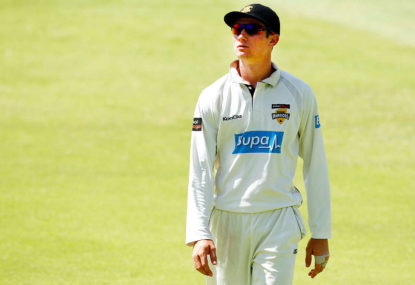I’m troubled. Are you troubled? Have you been taking note of the Australian Test batting selections over the past decade or so, and wondering why our selectors seem so conservative in who they pluck for a meteoric rise only to watch a meteoric fall?
Of course you’ve noticed. The issue dominates these forums with those for and against. But there seems to be this unwritten law among some of the choosers of these chancy challengers.
Select experienced older chumps before potential younger champs seems the motto. Play it safe.
Of course many will say that this is not entirely the Test selectors’ fault given the supposed dearth of potential young batting talent coming through. Ian Chappell rightly points out that Sheffield Shield teams too often are cluttered with dinosaurs (my term), not allowing the next generation to get a sense of what they need to reach the next stage from junior cricket.
Chappell suggests we should be promoting these kids earlier, at 17 or 18 years, and even if they struggle leave them to toughen up and develop their skills more quickly.
But it is concerning when you look at the ages of previous Australian Test batsmen when they began their careers compared to recent selection criteria.
A small sample of debut ages shows: Neil Harvey at 19, Norm O’Neill 21, Damien Martyn 21, Peter Burge 22, David Boon 23, Greg Chappell 22, Ian Chappell 21, Bob Simpson 21, Steve Waugh 20, Bill Lawry 24, Matthew Hayden 22, Doug Walters 20, Justin Langer 22, Donald Bradman 20, Ricky Ponting 21, and Michael Clarke 23.
Even Mark Waugh, who came to Test cricket late, was only 24. Overseas teams are a little different though some promote even earlier, with Gordon Greenidge at 23, Viv Richards 22, Brian Lara 21, Sir Garry Sobers 17, Sachin Tendulkar 16, and Martin Crowe 19.
Just check out the debut Test ages of England’s batsmen and all rounders in their present team. Joe Root 21, Alastair Cook 21, Ian Bell 22, Ben Stokes 22, James Taylor 22, Eoin Morgan 23, Chris Woakes 24, Ravi Bopara 24, and Alex Hales 25.
Despite some younger players finally coming through for Australia the present squad’s debut Tests were: Steven Smith 21, Mitch Marsh 23, Usman Khawaja 24, Joe Burns 25, David Warner 25, Shaun Marsh 28, Adam Voges 35. And that’s an improvement.
Compare that with some recent Australian batsmen and their age when first promoted to a Test position. Chris Rogers at 30, Ed Cowan 29, George Bailey 31, Rob Quiney 30, Alex Doolan 28, and Michael Hussey 29. One or two deserved selection earlier no doubt, but the pattern continued.
Of Australia’s recent group only Smith, who played his first Test at 21, Phillip Hughes at 20 and Mitch Marsh at 23 can be considered comparably youthful as debutants in recent past Australian sides compared to the present English side. And it doesn’t go unnoticed that those they picked earlier such as Smith, Warner, Khawaja (and Hughes would have been in the mix) have been the most successful, with Mitch Marsh a work in progress.
It’s obviously a difficult task getting the right balance and ensuring instant success, but playing it safe seems unlikely to achieve long-term gains. Only the naive would expect a young batsman to succeed immediately. Sometimes it takes years of development. It took Steve Waugh over three years to get beyond a Test average of 30, but selectors persevered with youth then.
Sometimes they don’t make the transition. But as Chappell points out in relation to Shield cricket, it seems the best way to improve skills is to throw the young into the next level early so they know what they have to work on to be successful.
Rather than go backwards by selecting an older and potentially less worthy batsman to fill a vacancy, it should almost always go to an up-and-comer such as Cameron Bancroft, Glenn Maxwell, Nic Maddinson, Marcus Stoinis, Peter Handscomb, Travis Head, Kurtis Patterson and Jono Dean.
At that age subsequently being dropped should not be seen as failure. It should be seen as part of the development of a future Test regular. They will improve quicker if they are given the chance.






























































































